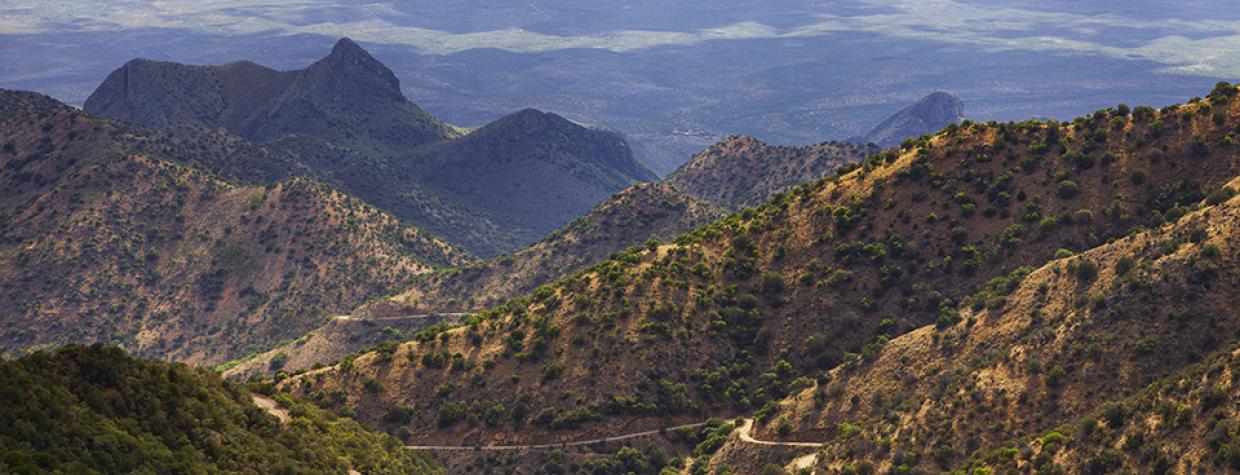Santa Rita Mountains, Coronado National Forest
Home to the Fred Lawrence Whipple Observatory, Mount Hopkins might be heaven on Earth for the star-struck. But the view of much of Southern Arizona from near this Santa Rita Mountains summit will send even the most grounded over the moon. You’ll need to reserve a tour to visit the observatory. But there’s an encapsulated version at the visitors center, plus a nearby astronomy viewing area if you want to use your own telescope. And on the drive to the top, there’s a wealth of history and natural beauty.
We begin our drive on an early November morning, when the cloud-streaked sky is as pale as a robin’s egg and the Santa Cruz Valley is tawny with fall grasses. As we turn onto Elephant Head Road, the observatory comes into view atop Mount Hopkins. Closer, Elephant Head, easily identified by its distinctive shape and lighter color, rises dramatically from the valley floor.
After turning right onto Mount Hopkins Road, we arrive at the visitors center about a mile past the Coronado National Forest boundary. Here, we find the only telescope system we can see without a tour. It’s impressive. The four gamma ray telescopes that make up the Very Energetic Radiation Imaging Telescope Array System (VERITAS) are mounted on 60,000-pound bases, and each 39-foot “dish” is made up of 345 mirrors and a camera.
Inside the visitors center, a short video recounts the history of the observatory and its telescopes, including the summit’s Multiple Mirror Telescope (MMT). That instrument is jointly operated by the Smithsonian Institution and the University of Arizona, and astronomers are using its data to create a 3D map of the universe. There’s also a replica of the MMT and, outside, a viewing scope trained on the real thing. A petroglyph discovered on the property is on display, along with information about local plants.
Back on the road, the pavement ends past the visitors center and remains gravel for most of the 8 miles to the observatory gate. The road edges along Montosa Canyon, where cottonwoods are just turning gold.
About 1.5 miles past the visitors center, we discover the astronomy overlook. Cement benches and pads form surfaces for telescopes, while interpretive panels describe the area’s geology and landmarks. To the south, a black hole marks the defunct Isabella Mine, one of many in the area; both Mount Hopkins and nearby Mount Wrightson were named for mining engineers killed by Apaches in the 1860s.
Past the vista, the road narrows. About 3.4 miles past the visitors center, the first of several views opens up, and each vista is more impressive than the last. Soon, we get our first glimpse of the telescopes on the ridge. They include MEarth, an automated system looking for other planets that might support life.
At the observatory gate, we come nearly head to head with the summit of Mount Wrightson, the Santa Ritas’ tallest peak. We pause here to take in the dizzying view before heading back down, feeling giddy from the altitude and as expansive as the sky.
Note: Mileages are approximate.
Length: 19.2 miles one way (from Interstate 19)
Directions: From Tucson, go south on Interstate 19 for 40 miles to Canoa Road (Exit 56). At the traffic circle, go under the highway to reach the I-19 frontage road. Turn right (south) onto the frontage road and continue 3.2 miles to Elephant Head Road. Turn left onto Elephant Head Road and continue 1.5 miles to Mount Hopkins Road. Turn right onto Mount Hopkins Road and continue 14.5 miles to the Fred Lawrence Whipple Observatory entrance gate.
Vehicle requirements: None in good weather.
Special considerations: The observatory’s visitors center is open from 8:30 a.m. to 4:30 p.m. Mondays through Fridays, excluding federal holidays, and is free to visit. Tours of the observatory are generally available Mondays, Wednesdays and Fridays from mid-March through November, weather permitting. Reservations are required, and there is a fee.
Information: Nogales Ranger District, 520-281-2296 or www.fs.usda.gov/coronado; Fred Lawrence Whipple Observatory (tours), 520-879-4407 or www.cfa.harvard.edu/flwo

